#Celtic Revival
Explore tagged Tumblr posts
Text
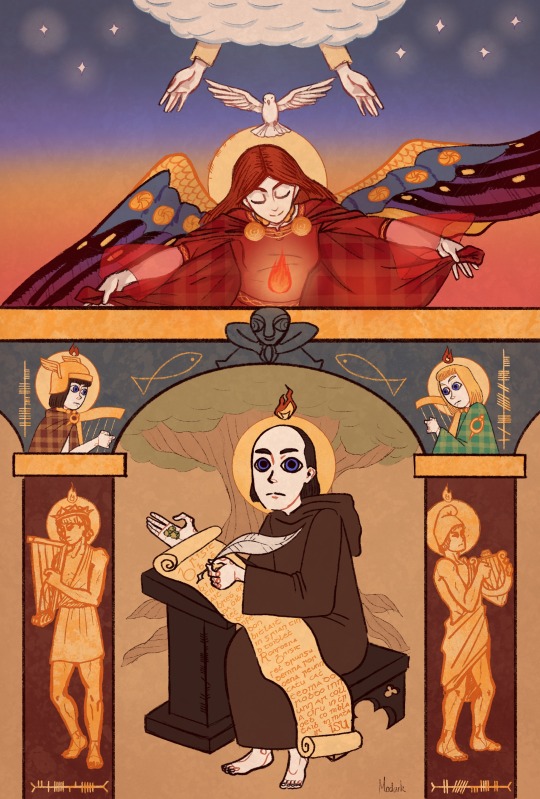
The Bardic Tradition
I made a long thread explaining in detail all the symbolism in this piece when I first posted it. That's lost to time now, thanks Elon. I'll try to rewrite it to the best of my ability in an abridged form.
The basic gist is that its a visual representation of the ancient Gaelic bardic tradition. Seated in the center is St. Colmcille, composing an old Irish hymn to St. Brigid, "Brigit bé bithmaith". He is holding hazel nuts, symbols of knowledge / inspiration in Irish legend. On the two pillars on either side of him are King David (left) and Orpheus (right), two famous poets from antiquity. Two legendary poets from Irish legend, Oisín and Amergin, are situated above each pillar respectively. The two fish are seen swimming "upstream" (as in the legend of the Salmon of Knowledge) toward a sheela na gig, a architectural feature / grotesque of early Irish churches which some consider to be symbols of femininity, meant to ward off evil. At the top of the image, hands from a cloud (representing God) release a white dove (representing the Holy Spirit) down to St. Brigid. She owes her angelic appearance to her being considered both a pagan goddess and Christian saint. She is guarding a flame, which symbolises poetic inspiration, and which can be seen floating above the heads of all the other figures.
#celtic#irish#poetry#celtic mythology#irish mythology#irish culture#ireland#celtic culture#celtic christianity#druidry#druidism#bardic inspiration#imbas#imbas forosnai#celtic revival#gaelic#st brigid#saint brigid#mythology#digital art#mediaeval#medieval art#medieval manuscripts#illuminated manuscript#celtic design#irish history#awen#esotericism#spirituality#paganism
124 notes
·
View notes
Text

John Duncan's Riders of the Sidhe
#riders of the sidhe#john duncan#symbolism#symbolist art#celtic revival#irish folklore#irish mythology
86 notes
·
View notes
Text

John Duncan (1913), Saint Bride
10 notes
·
View notes
Text
Faeries and the Celtic Revival
A cultural movement known as the Celtic revival, which peaked in the late 19th and early 20th centuries, aimed to revive interest in the folklore, mythology, and antiquated customs of Ireland and other Celtic countries. The fascinating realm of faeries, which greatly influenced its literature, art, and cultural identity, was essential to this Renaissance. The Aos Sí, often known as faeries, are ethereal creatures from Irish mythology that are frequently portrayed as supernaturally gifted nature spirits. These creatures came to symbolize the magical and otherworldly facets of Celtic culture during the Celtic Revival, signifying a romanticized and idealized link to a pre-Christian past. Faerie mythology was a source of inspiration for authors and artists, who used it to create stories that stood in stark contrast to the period's industrialization and modernization by inspiring awe and mystery.
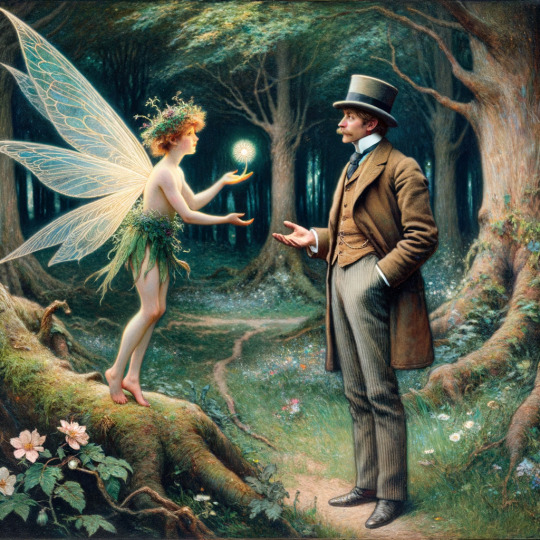
Literature greatly influenced the Celtic Revolution, with faeries frequently appearing in the writings of significant authors like Lady Gregory and W.B. Yeats. Yeats in particular was enthralled with Irish folklore, and faerie themes frequently appeared in his plays and poetry. He saw them as representations of the creative and spiritual depth of Irish culture, and he used their tales to examine nationalist ideas, identity, and the conflict between the old and the new. In addition to literature, the Celtic Revival's visual arts significantly incorporated faerie imagery. Artists such as John Duncan and George William Russell (Æ) combined old Celtic elements with contemporary techniques to create elaborate faerie images in their works. These artworks not only emphasized the artistic characteristics of faerie mythology, but also served as a form of cultural resistance against the homogenizing pressures of British rule by highlighting the uniqueness of Celtic ancestry. The Celtic Revival's faeries were also crucial to the era's larger political and cultural environment. As Ireland sought independence, the resurgence of Celtic mythology, including faerie tales, entwined itself with nationalist aspirations. Because of their mysterious and elusive character, faeries came to represent Ireland's spirit and tenacity. They provided a means of expressing pride and cultural identity, which sparked a resurgence of interest in the Gaelic language and traditional arts.
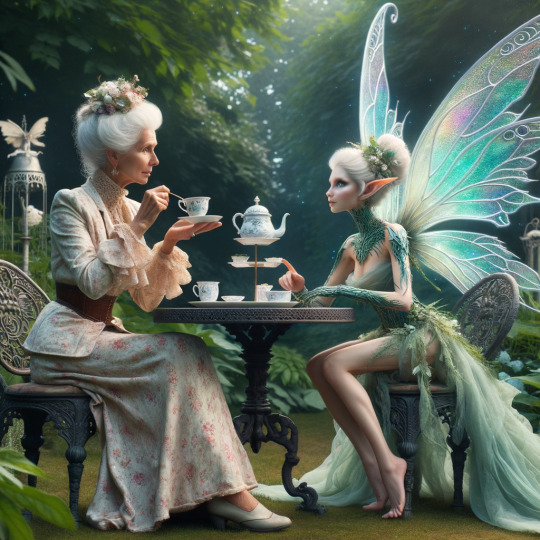
Furthermore, the resurgence of fairy tales was a dynamic process of cultural reinterpretation rather than just a nostalgic endeavor. Modern audiences reworked the Faeries, frequently emphasizing themes of change and metamorphosis. Because of its flexibility, the faerie tradition was able to stay entrenched in old traditions while keeping dynamic and current, addressing contemporary challenges. All things considered, faeries had a significant and varied role throughout the Celtic Revival. They represented the Celtic nations' rich cultural legacy by serving as links between the actual and the imagined, the past and the present. Faeries contributed to a Renaissance that involved an imaginative investigation of the magical elements of Celtic mythology as well as an identity reclamation through literature, art, and cultural expression. Their continued involvement in the Celtic Revival highlights their importance as cultural icons, personifying the complexity and continuing appeal of the Celtic spirit.
#w.b. yeats#william butler yeats#lady gregory#celtic revival#celtic folklore#celtic#faeries#fae folk#fae#faerie art#faerie#fairies#fairy art
12 notes
·
View notes
Text
𝗗𝗮𝗶𝗹𝘆 𝗗𝗶𝘃𝗶𝗻𝗮𝘁𝗶𝗼𝗻: Idad / Yew

It's likely that a past cycle is coming to a close. Idad holds strong ties to death, ancestors, and the elderly. We're likely in the transitional stage where something must die so the next steps can be taken. As we pass through this phase of transition we are being asked to look back on and respect the lessons we have learnt from our past experiences. We have likely matured a lot from where we once were and can use this knowledge to guide us in our next steps. From a more magickal perspective Idad could be drawing our attention to the long lasting traditions that stay lit within us that have been passed down from generation to generation. It would be very beneficial to study the past and the roots of all things on this day. Perhaps our ancestors know something that we do not.
©️Sagans Sorcery 🔥🖋️
[ Tip jar ]
Please check out my Ogam divination services below:
𝗢𝗴𝗮𝗺𝘀
• 3 Ogam spreads for £5 GBP
- Past, present, future
- Situation, action, outcome
- Overlook
• 1 Ogam readings for £2
For a full list of my services and disclaimer please see the featured post pinned on the Sagans Sorcery page.
All readings will be delivered as a photograph and a detailed write up in your inbox or to your email account.
I can usually fulfil requests within 72 hours.
All readings are completely private and confidential.
Please DM me for any information you may need to get your reading underway.
Thank you for taking interest in Sagans Sorcery ✨🙏✨
#daily divination#sagans ogams#sagans oghams#sagans sorcery#daily ogam#daily ogham#ogam services#ogam readings#ogam divination#ogams#ogham readings#ogham divination#ogham#ogham services#ogham reader#ogam reader#divination#magick#sagans divinations#divinations#sorcery#sorceress#druidic#druid#druidry#celtic trees#celtic#celtic revival#celt#pagan witch
12 notes
·
View notes
Text
youtube
We are back with another edition of our CREATURE DOUBLE FEATURE where we discuss TWO different artworks by TWO different artists and compare what makes them so terrifying!
Usually, we are able to squeeze them into one episode but not this time!
We kick off our 2025 CDF edition with illustrator, painter, and stained glasser Harry Clarke (1889-1931).
Whoo-ee, y’all, what a journey this one has been!
Part of our process of building our episodes includes immersing ourselves in the time and place these artists worked - we want to know what they were seeing, hearing, smelling, tasting?
This time it included watching Derry Girls and traveling (virtually) to the mecca of the Irish Celtic Revival: the enchanting Aran Islands off the Western coast of Ireland.
ARAN ISLAND
It also led us to really ponder what made Harry’s vib different from his predecessor Aubrey Beardsley (1872-1898), known for his grotesque and erotic black ink drawings, but also from the many overlapping movements happening at this time: Arts and Crafts, Art Nouveau, Celtic Revival, Irish Revival, Gothic Revival and many more.
AUBREY BEARSLEY
Harry hailed from Dublin, Ireland and was just as popular for his book illustrations during the Golden Age of gift-books as well as his other-wordly stained glass in churches.
STAINED GLASS - GENEVA WINDOW
While his masterpiece is the Geneva Window, a breathtaking example of Harry’s skill and mastery of stained glass, we will be focusing on an illustration from the book of Tales of Mystery and Imagination by Edgar Allen Poe (1919, 1923).
Yes, horror-ific Edgar. Allen.Poe.
The work in question is that of “King Pest” from 1919, a story about two drunken sailors bumbling about a 19th century plague-stricken London.
KING PEST
Sounds chill but the combo of grim and gory Poe plus Harry’s scary talent of visualizing such tales will give you the heebie-jeebies (not all speaking from experience 👀).
Click PLAY if you dare and get ready to be HARRY-FIED!
Topics include E-Girl socks, El Chavo del Ocho, island getaways, pampooties, Derry Girls, Guinness, TB vaccines and much, much more!
The Pantry in this ep’ is “Horror Vacui”.
And, of course, we want to hear from YOU!
What are YOUR favorite Harry Clarke illustrations from Tales of Mystery and Imagination?
Some of our favorites include “The Tell-Tale Heart” “The Assignation”
#art history#harry clarke#harry clarke illustrations#celtic revival#irish artists#artslicepod#tales of mystery and imagination edgar allen poe#edgar allan poe#Youtube
2 notes
·
View notes
Text
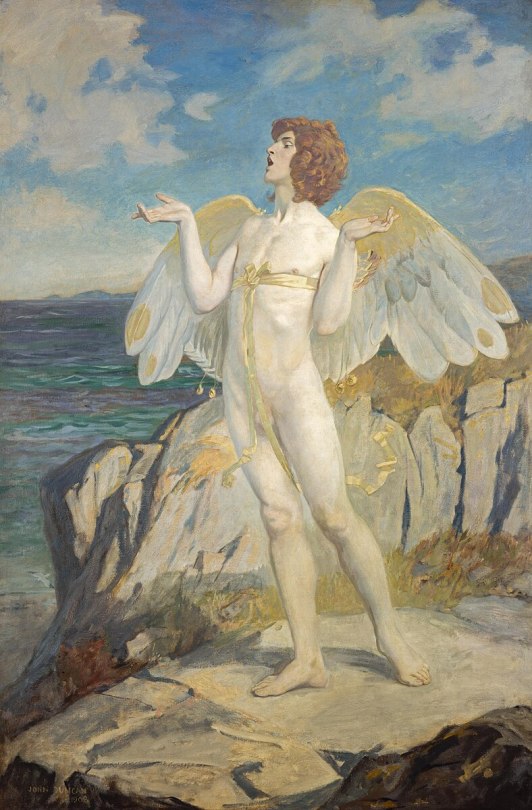

Angus Og, God of Love and Courtesy, Putting a Spell of Summer Calm on the Sea. (John Duncan, 1908) Oil on canvas / Chalk on paper
#john duncan#celtic art#scottish art#angus og#symbolism#i got this image from wikipedia cause the national gallery one is insanely crusty. this is why i cant trust the other tumblr uploaders#celtic revival#pre raphaelite
29 notes
·
View notes
Text
Samhain is soon!
"My father loved his country
And sleeps within its breast
While I that would have died for her
Must never so be blessed"
Samhain will dawn, from the sunset or the 31st till the sunset on the 1st of November! How honourable a day it, when Celtic men are proud and glad of their hearth and kindred. But as we celebrate and invite spirits of all walks while warding off mischievous fairies we cannot forget in our mourning of them and the deeds they have done. For though Samhain blankets us with the year’s first frost, we must celebrate more than the end of the harvest or the spirits of our ancestors. For there are those who fought and died that we might live on more.
Our history is full of those who stood against colonial powers, and tonight, I light a candle for the brave souls who fought in battles and uprisings. There is no greater honour than to give ones life for their Celtic race. Brave men like William Wallace! Of course, not the Hollywood version played by Kiwi anti Semite but the real man who rallied a nation with grit and resilience. Or the fierce and venerable Gaelic women of Cumann na mBan who resisted in the fight for Irish independence and never surrendered. And how can I remove honour from who fought silently? Those that continued to speak our languages, customs, and beliefs when both state and society tried to erase them? The faithful elect who lived away for centuries in shame and dishonour? All for that hopeful promise that their country would survive and our fathers legacy would not be stained by the filth and the impure stain of collaboration?
Our race is going to survive. Despite everyone and everything her tongue and blood have endured. Despite England we are still here, Despite the Danes we are still here and despite the Romans we are still here and we will outlive them. What remains now of Rome? That great Empire which conquered the Brythonics but were taught rightly in the misty hills of Alba? It's now simply ruins while our people still live, while our race still beats high with hope. The Danes? What remains of the Viking hordes who were beaten by the Gaels of Eirinn and Alba? Or of the proud Saxon? Who was resisted, with varying fortunes, by all Celts bar our Vretoned brothers?
We are just one race, all of us. The seed of the Gael and Brythonics must join hands for Celtdom and Celtdom alone. No more foreign imposition and diktat which brings only misery nor internal petty squabbles but instead a single host. A single flag, a single race which will surely be glorious. Once the Celts unite you can be sure that the vile Saxon will abandon his post and lose his fighting spirit. Once the Celts unite we will again be prosperous, trade and wealth will flow freely between the nations. The Celtic Man is naturally industrious and an intellectual with great venerable attributes. Alas, sadly, who is pulled down by foreign impositions of vice like alcoholism, drugs and the like which has made our race weak. We have fallen asleep, a deep sleep of domestication, of being conquered, of sufferance and shame with great dishonour. Which infest every carpet or our society, but if the promised day comes and all the Celts awaken then the dogs shall become wild again! And the wild dogs will chase out the foreigner and the traitor and the Celtic spirit will never again be wrong to us. I guarantee a united Celtic nation would become a prospoerus Republic within ten years of unity. It would surpas the living standards within five and he comparable only to the Nordic lands within ten and would surely outgrow them. We are an industrious race of hard workers, of intelligent men and woman and a race deeply stubborn and proud and those are good things! If we work hard the Celts can achieve anything under the sun and we will obtain our dream of a prosperous, peaceful, stable and loving pan Celtic state from Scotland till Kernow till Vreton.
I have total confidence that this will happen, it's a divine promise. I've done some early divination for the year and I am certain it's due to happen. I can give no date but all the signs suggest that the lot awaited day is coming. I'm unsure if I should ever had the great joy of seeing it but probably not.
2 notes
·
View notes
Text

Angel in the city: The Awakening
Phoebe Anna Traquair
National Galleries of Scotland
Edinburgh
#found#art#modern art#angels of edinburgh#angel#angels in art#angels#Phoebe Anna Traquiar#symbolism#Celtic revival#scottish artist#scotland#Scottish art#women’s art#women in art#20th century
5 notes
·
View notes
Text
youtube
Last summer, I had the absolute privilege of discussing the elixir of feminism, Irish mythology, and Rossettian aesthetics that make up Katharine Tynan's poetic retelling of Tóraíocht Dhiarmada agus Ghráinne at the Tate Britain. A highlight of 2023!
#I really will yap about Diarmuid and Gráinne forever#irish mythology#the pursuit of Diarmuid and Gráinne#tóraíocht#tóraíocht dhiarmada agus ghráinne#Tate Britain#Katharine Tynan#Irish Revival#Celtic Revival#Rossetti#pre raphaelite#dante gabriel rossetti#The Rossettis: In Relation#The Rossettis: Radical Romantics#Youtube
0 notes
Text

PHOEBE ANNA TRAQUAIR (1852-1936), Love, the Comforter of Night | Christie's
#PHOEBE ANNA TRAQUAIR#celtic revival#scottish art#scottish painting#religious art#celtic revivalism#female artists
2 notes
·
View notes
Text

‘is fheàrr gàidhlig bhriste na gàidhlig anns a’ chiste!’
[better broken gaelic than dead gaelic]
90 notes
·
View notes
Text
𝗗𝗮𝗶𝗹𝘆 𝗗𝗶𝘃𝗶𝗻𝗮𝘁𝗶𝗼𝗻: Idad / Yew

It's likely that a past cycle is coming to a close. Idad holds strong ties to death, ancestors, and the elderly. We're likely in the transitional stage where something must die so the next steps can be taken. As we pass through this phase of transition we are being asked to look back on and respect the lessons we have learnt from our past experiences. We have likely matured a lot from where we once were and can use this knowledge to guide us in our next steps. From a more magickal perspective Idad could be drawing our attention to the long lasting traditions that stay lit within us that have been passed down from generation to generation. It would be very beneficial to study the past and the roots of all things on this day. Perhaps our ancestors know something that we do not.
©️Sagans Sorcery 🔥🖋️
[ Tip jar ] ✨🙏✨
Please check out my Ogam divination services below:
𝗢𝗴𝗮𝗺𝘀
• 3 Ogam spreads for £5 GBP
- Past, present, future
- Situation, action, outcome
- Overlook
• 1 Ogam readings for £2
For a full list of my services and disclaimer please see the featured post pinned on the Sagans Sorcery page.
All readings will be delivered as a photograph and a detailed write up in your inbox or to your email account.
I can usually fulfil requests within 72 hours.
All readings are completely private and confidential.
Please DM me for any information you may need to get your reading underway.
Thank you for taking interest in Sagans Sorcery ✨🙏✨
#daily divination#daily readings#daily ogam#daily ogham#sagans ogams#sagans oghams#sagans divinations#sagans sorcery#ogam services#ogam readings#ogam divination#ogams#ogam#ogham readings#ogham divination#ogham staves#oghams#ogham#ogam staves#ogam magick#ogham magick#druidic#druid#druidism#druids#celtic trees#celtic#celtic ogam#celtic revival#magick
5 notes
·
View notes
Text
Think this is the book, though not much more in the way of illustrations available to load
More here:
http://www.fairyroom.ru/?p=13476

Gaelic Fairy Tales
Archibald Sinclair, Glasgow
1908
Artist : katharine Cameron
#Archibald Sinclair#Katherine Cameron#illustration#art#gaelic#fairy tales#celtic#celtic revival#Glasgow girls
174 notes
·
View notes
Text
Paxuson Part 1: Introduction and Comparison of Cognates
A god of bidirectionality, of liminanlity, paths, doorways, travelers, wealth, shepherds, animals, and fertility. His name means "protector" and his direct linguistic cognates are Pan and Pushan.

Pan, Lord of the Wilds
Pan is the god of the wild, shepherds and flocks, rustic music and impromptus, and companion of the nymphs. He is also recognized as the god of fields, groves, wooded glens, and often affiliated with sex; because of this, Pan is connected to fertility and the season of spring. His origin and source of worship was in Arcadia, an isolated mountainous region of the Peloponnese whose culture is . It is believed that Hermes was originally an epithet of Pan who split off early on and becomes a separate deity associated with boundaries, roads, travelers, merchants, thieves, athletes, shepherds, commerce, cunning, and messages.
Both Hermes and Pan have myths putting in them in relation to Apollon. Hermes is characterized as being nurtured by Apollon who acts as a sort of patron to the young god. Pan and Apollon had a famed music competition in the myth of Midas. Given that we have established Apollon as a cognate of Rudlos, lets keep this in mind.

Pushan by OverlySarcasticProductions
Pushan, The Far-Roaming Shepherd
God of meetings, marriages, journeys, roads, fertility, sheep, and cattle. He is called to stir sexual desire in the bride on her wedding day. He is often seen as a solar deity, although this is connected to his shepherd aspect pretty explicitly.
He was a psychopomp, conducting souls to the other world. He protects travelers from bandits and wild beasts, and protects men from being exploited by other men. He is a supportive guide, a "good" god, leading his adherents towards rich pastures and wealth. His chariot is pulled by goats.
While there are multiple versions of the tale, it is commonly said that Rudra knocks out Pushan's teeth at the Daksha yajna, although he doesn't seem to be the target of his rage.

Cernunnos, The Horned Lord
Cernunnos, A Gaulic deity, whose name is probably more accurately rendered as *Karnonos, meaning "Horned Lord". Through the Pillar of the Boatmen, the name "Cernunnos" has been used to identify the members of an iconographic cluster, consisting of depictions of an antlered god (often aged and with crossed legs) associated with torcs, ram-horned (or ram-headed) serpents, symbols of fertility, and wild beasts (especially deer).
Ceisiwr Serith has an excellent dissection of symbols and character in his Youtube video essay, Cernunnos: Looking Every Which Way. Cernunnos has been variously interpreted as a god of fertility, of the underworld, wealth and trade, and of bi-directionality. Cernunnos has been tentatively linked with Conall Cernach, a hero of medieval Irish mythology, and some later depictions of cross-legged and horned figures in medieval art.

Kurunta, The Deer Hunter
His name seems to be cognate with Hittite Kurunta. His sacred animal is the stag, although this was not exclusive to him. He is commonly depicted standing on a stag, and Hittite texts identify the god standing on the stag as the god of the countryside. In Yazilikaya, a tutelary god of nature (likely Kurunta as the god is accompanied by the antler sign) is depicted with only a crook. There are also parallels with Kurunta following behind a storm god, as seen in a sea of Mursili III and a relief from Aleppo. There are also depictions of Kurunta holding a bow and arrows, which outside of due to him being a tutelary god also connects him to hunting. The hunting aspect was also emphasized by Tudhaliya IV.

Pashupati, Shiva of the Animals
Over in India, particularly in the east, another cognate of Rudlos, The mighty Rudra, is widely known by his epithet and avatar, Pashupati, who may be related to Paxuson. The name means "Lord of the Animals". While he may be related to the pre-Indo-Aryan deity depicted on the eponymous Pashupati seal of the Indus Valley Civilization discovered in modern day Pakistan, I believe he may be a reflex, or at least influenced by, the PIE deity in question.
In the Atharvaveda, the fourth Veda and one of the later additions to Vedic literature, Rudra is described to be the lord of the bipeds and the quadrupeds, including creatures that inhabited the earth, woods, the waters, and the skies. His lordship over cattle and other beasts denoted both a benevolent and destructive role; he slew animals that incurred his wrath, but was also kind to those who propitiated him, blessing them with health and prosperity. He is also seen a tutelary deity, of the nation of Nepal in particular.
#deity worship#pagan#pagan revivalism#paganism#pie paganism#pie pantheon#pie polytheism#pie reconstructionism#pie religion#proto indo european paganism#hellenic worship#hellenic deities#hellenic polytheism#hellenic pagan#hellenic polythiest#hellenism#hellenic paganism#hellenic devotion#celtic paganism#celtic polytheism#celtic deities#celtic gods#gaulish paganism#gaulish polytheism
22 notes
·
View notes
Text
I obsess over two poems

"The drum pounds to the step of the Vreton And in fearless combat, Arthur will return!" This part got me, the same faith and honour in the ultimate ideal. But the next part is what got me the most.
youtube
"The soul of the (Celtic) race resounds in our hearts, And the Celtic spirit, she can not be wrong to us! Nevenoe and Kadoudal calls us to the moorland The French, frightened as they see us to go to battle!"
And such a simple refrain at the end, "For our life, bread, freedom and peace! To build the foundations of a better world!"
And the end, a great rallying cry. "Arise, victory will be ours if we endure the pain. THe old enemy, shall suffer with great harshness! The holy sunlight will illuminate the beautiful day ANd we will gain justice for the Vreton State!"
I love this song so much, I don't speak Vreizh so I couldn't really follow along but I do speak good enough French, and this video had french subtitles and then it closes with a picture of two Vreton men showing their national pride, I love it!
Every Celtic nation must have this spirit, the Celtic spirit is not wrong to us either! We must gain justice for the Albannach state and make the false Saxon reel again. The Vretons are an inspiration to me. Such a faitful and patrotic nation, we are lucky to be their brothers. If we can ever create a Pan Celtic nation, which I faithfully believe in, we must include them!
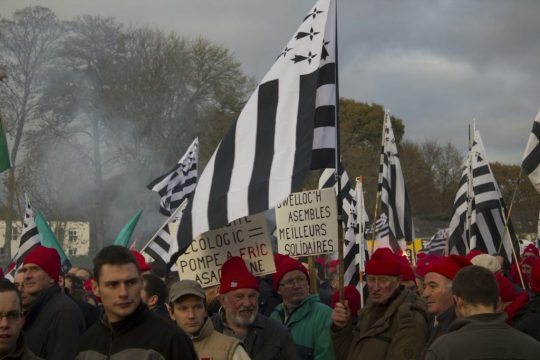
It kinda reminds me of a favourite song of mine, til Ungdommen, or "to the youth." Which is my favourite song in human existence.
"Besieged by enemies, walk the path of your time Under a bloody storm, commit yourself to war!"
youtube
It starts strong, commit yourself to a war! And your only sword is the faith in humanities worth, that's what I love about this song. And then comes the victory, "Quietly conveys the grenades rolling belt, stop their drive for death! Stop them with spirit!" War is contempt for life, peace is to create! Throw in all your might and death will lose! Love and enriched is that dream, everything great that was! Go for the unknown, wrest for her answers! Uninhabited power stations, unknown stars Create them, with spared lives, you bold (youthful) brains! Noble is man, the earth is rich! If distress and hunger is found here? It is because of (fraternal) betrayal! Crush it! In life's name will injustice fall! And sunshine, bread and spirit, owned by all! Then drop the weapons, powerlessly down If we create respecte for life, we create peace."
This is the meat of the poem, in my opinion and it's peak. The beautiful imagery, the hope, the unbridled pure hope. Naive though it may be, it's hope, pure, unadulterated hope and faith in our common goodness to create a better world. A world where no mother mourns her son, where no one goes hungry, this faith and hope dashed just a few years after but still resounds in our hearts. Listening to it just fills you with human pride, human desire and human warmth. Ack! I am gushing again, I must stop myself, oh well

The man who wrote this poem would be sadly murdered during the war. He became a Marxist and became a Norwegian soldier. He fought bravely, he fought unconquerably and defied the fascist scum. What a hero, what a god damn hero.

4 notes
·
View notes